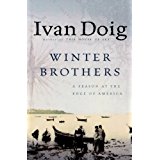 The Natural History Book Club book selection for November/December 2016 is Winter Brothers: A Season at the Edge of America by well-known Northwest author Ivan Doig. We will meet on Monday, December 5, 2016 from 3:30-5:00. E-mail Jean at jltnatural@saveland.org for location.
The Natural History Book Club book selection for November/December 2016 is Winter Brothers: A Season at the Edge of America by well-known Northwest author Ivan Doig. We will meet on Monday, December 5, 2016 from 3:30-5:00. E-mail Jean at jltnatural@saveland.org for location.
Ivan Doig describes this book as a “journal of a journal.” James Gilchrist Swan was one of the first Europeans in the Pacific Northwest. He kept extensive daily journals of his activities. We previously read The Northwest Coast, which was Swan’s journals of his first three years in Washington Territory in the mid-1800s in what is now southern Washington State. Winter Brothers is a fusion of Doig’s winter of 1978-79 in more northern parts of Washington State with Swan’s journals of 1862-1898 in those same locations. Two prominent locations are Neah Bay and Port Townsend.
This book is a unique blend of modern author (Ivan Doig) with historically important Pacific Northwest pioneer (James Swan).



